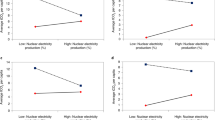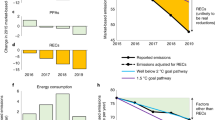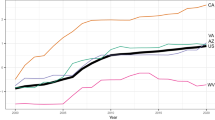Abstract
States have historically been the primary drivers of climate change policy in the US, particularly with regard to emissions from power plants. States have implemented policies designed either to directly curb greenhouse gas (GHG) emissions from power plants, or to encourage energy efficiency and renewable energy growth. With the federal government withdrawing from the global climate agreement, understanding which state-level policies have successfully mitigated power-plant emissions is urgent. Past research has assessed policy effectiveness using data for periods before the adoption of many policies. We assess 17 policies using the latest data on state-level power-sector CO2 emissions. We find that policies with mandatory compliance are reducing power-plant emissions, while voluntary policies are not. Electric decoupling, mandatory GHG registry/reporting and public benefit funds are associated with the largest reduction in emissions. Mandatory GHG registry/reporting and public benefit funds are also associated with a large reduction in emissions intensity.
This is a preview of subscription content, access via your institution
Access options
Access Nature and 54 other Nature Portfolio journals
Get Nature+, our best-value online-access subscription
$29.99 / 30 days
cancel any time
Subscribe to this journal
Receive 12 print issues and online access
$209.00 per year
only $17.42 per issue
Buy this article
- Purchase on Springer Link
- Instant access to full article PDF
Prices may be subject to local taxes which are calculated during checkout


Similar content being viewed by others
References
Friedrich, J. and T. Damassa. The History of Carbon Dioxide Emissions (World Resources Institute, last modified 21 May 2014, accessed 5 April 2017); http://www.wri.org/blog/2014/05/history-carbon-dioxide-emissions
Sources of Greenhouse Gas Emissions (U.S. Environmental Protection Agency, 2015, accessed 8 September 2017); https://www.epa.gov/ghgemissions/sources-greenhouse-gas-emissions
Rabe, B. G. Statehouse and Greenhouse: The Emerging Politics of American Climate Change Policy (Brookings Institution Press, Washington, DC, 2004).
Goulder, L. & Stavins, R. Challenges from state-federal interactions in US climate change policy. Am. Econ. Rev. 101, 253–257 (2011); http://www.jstor.org/stable/29783749 retrieved from.
Grant, D., Bergstrand, K. & Running, K. Effectiveness of US state policies in reducing CO2 emissions from power plants. Nat. Clim. Change 4, 977–982 (2014).
Climate Change 101: State Action. Climate Change101: Understanding and Responding to Global Climate Change (Center for Climate and Energy Solutions, 2011).
Wheeler, S. State and municipal climate action plans: The first generation. J. Am. Plann. Assoc. 74, 481–496 (2008).
Yin, H. & Powers, N. Do state renewable portfolio standards promote in-state renewable generation? Energy Policy 38, 1140–1149 (2010).
Carley, S. State renewable energy electricity policies: An empirical evaluation of effectiveness. Energy Policy 37, 3071–3081 (2009).
Michaels, R. J. National renewable portfolio standard: Smart policy or misguided gesture? Energy Law J. 29, 79–119 (2008).
Delmas, M. A. & Montes-Sancho, M. J. U.S. state policies for renewable energy: context and effectiveness. Energy Policy 39, 2273–2288 (2011).
Menz, F. C. & Vachon, S. The effectiveness of different policy regimes for promoting wind power: experiences from the states. Energy Policy 34, 1786–1796 (2006).
Shrimali, G. & Kniefel, J. Are government policies effective in promoting deployment of renewable electricity resources? Energy Policy 39, 4726–4741 (2011).
Drummond, W. J. Statehouse versus greenhouse. J. Am. Plann. Assoc. 76, 413–433 (2010).
Climate Policy Maps (C2ES, 2016, last modified September 2016; accessed 5 April 2017; https://www.c2es.org/us-states-regions/policy-maps/emissions-targets
Prasad, M. & Munch, S. State-level renewable electricity policies and reductions in carbon emissions. Energy Policy 45, 237–242 (2012).
Lyon, J. W. M. Environmental public voluntary programs reconsidered. Policy Stud. J. 35, 723–750 (2007).
Matisoff, D. Sources of specification errors in the assessment of voluntary environmental programs: understanding program impacts. Policy Sci. 48, 109–126 (2014).
Pigou, A. C. The Economics of Welfare. (Macmillan and Co., London, 1920).
Montgomery, W. D. Markets in licenses and efficient pollution control programs. J. Econ. Theory 5, 395–418 (1972).
Stavins, R. N. What can we learn from the grand policy experiment? Lessons from SO2 allowance trading. J. Econ. Perspect. 12, 69–88 (1998).
Goulder, L. H. & Parry, I. W. H. Instrument choice in environmental policy. Rev. Environ. Econ. Policy 2, 152–174 (2008).
Multi-State Climate Initiatives (C2ES, 2017, accessed 5 April 2017; https://www.c2es.org/us-states-regions/regional-climate-initiatives
State CO 2 Emissions from Fossil Fuel Combustion, 1990-2014 (U.S. EPA, 2016, accessed 5 April 2017; https://www.epa.gov/sites/production/files/2017-07/documents/co2ffc_2014.pdf
Morey, M. J. & Kirsch, L. D. Retail Choice in Electricity: What have we Learned in 20 Years? (EMRF, 2016); https://sites.hks.harvard.edu/hepg/Papers/2016/Retail%20Choice%20in%20Electricity%20for%20EMRF%20Final.pdf
State Carbon Dioxide Emissions (U.S. Energy Information Administration, 2016, accessed 5 April 2017; https://www.eia.gov/environment/emissions/state/
Kaya, Y. Impact of Carbon Dioxide Emission Control on GNP Growth: Interpretation of Proposed Scenarios (IPCC, 1990).
Nakicenovic, N. & Swart, R. (eds.) in Special Report on Emissions Scenarios Ch. 3 (IPCC, 2000).
Public Benefit Funds (C2ES, 2014, last modified 2014, accessed 5 April 2017; https://www.c2es.org/us-states-regions/policy-maps/public-benefit-funds
Kim, S. E., Yang, J. & Urpelainen, J. Does power sector deregulation promote or discourage renewable energy policy? Evidence from the states, 1991–2012. Rev. Policy Res. 33, 22–50 (2016).
Net Generation by State by Type of Energy Producer by Energy Source. (U.S. EIA, 2016, accessed 8 August 2017; https://www.eia.gov/electricity/data/state/
Kaya, K. Y. Environment, Energy, and Economy: Strategies for Sustainability (United Nations University Press, New York, 1997).
Rosa, E. A. & Dietz, T. Human drivers of national greenhouse-gas emissions. Nat. Clim. Change 2, 581–586 (2012).
Lyon, T. P. & Yin, H. Why do states adopt renewable portfolio standards? An empirical investigation. Energy J. 3, 133–157 (2010).
Author information
Authors and Affiliations
Corresponding author
Additional information
Publisher’s note: Springer Nature remains neutral with regard to jurisdictional claims in published maps and institutional affiliations.
Electronic supplementary material
Supplementary Information
Supplementary Information Supplementary Appendices 1–8 and Supplementary References
Rights and permissions
About this article
Cite this article
Martin, G., Saikawa, E. Effectiveness of state climate and energy policies in reducing power-sector CO2 emissions. Nature Clim Change 7, 912–919 (2017). https://doi.org/10.1038/s41558-017-0001-0
Received:
Accepted:
Published:
Issue Date:
DOI: https://doi.org/10.1038/s41558-017-0001-0
This article is cited by
-
Motivated reasoning about climate change and the influence of Numeracy, Need for Cognition, and the Dark Factor of Personality
Scientific Reports (2024)
-
How climate policy commitments influence energy systems and the economies of US states
Nature Communications (2023)
-
National strategy for climate change adaptability: a case study of extreme climate-vulnerable countries
Environment, Development and Sustainability (2023)
-
Global declarations on electric vehicles, carbon life cycle and Nash equilibrium
Clean Technologies and Environmental Policy (2023)
-
Renewables, taxes and competitive markets: the role of energy policies on the EU’s sustainable energy consumption
Environment, Development and Sustainability (2023)



